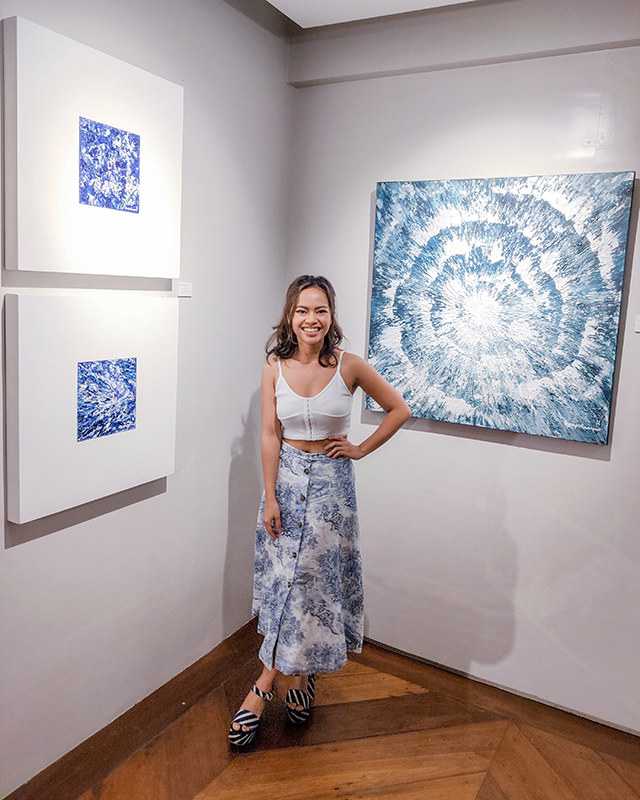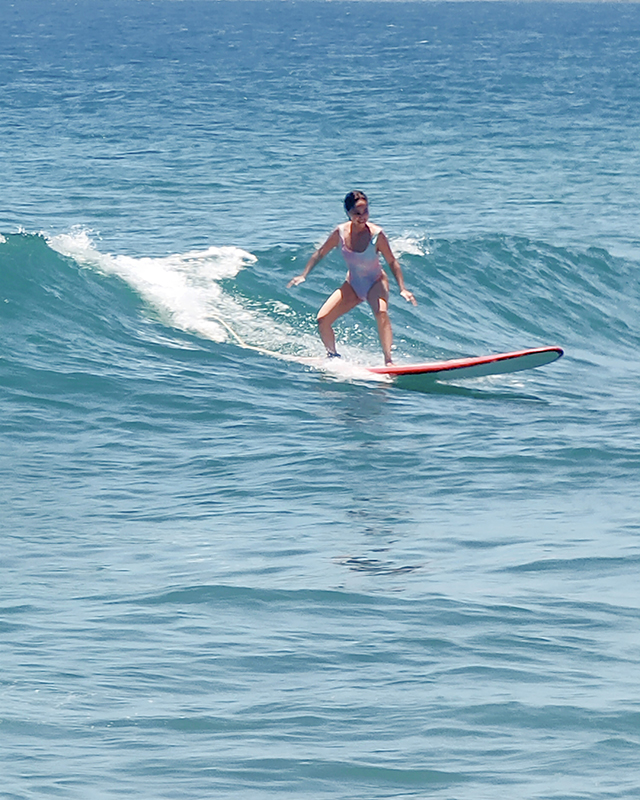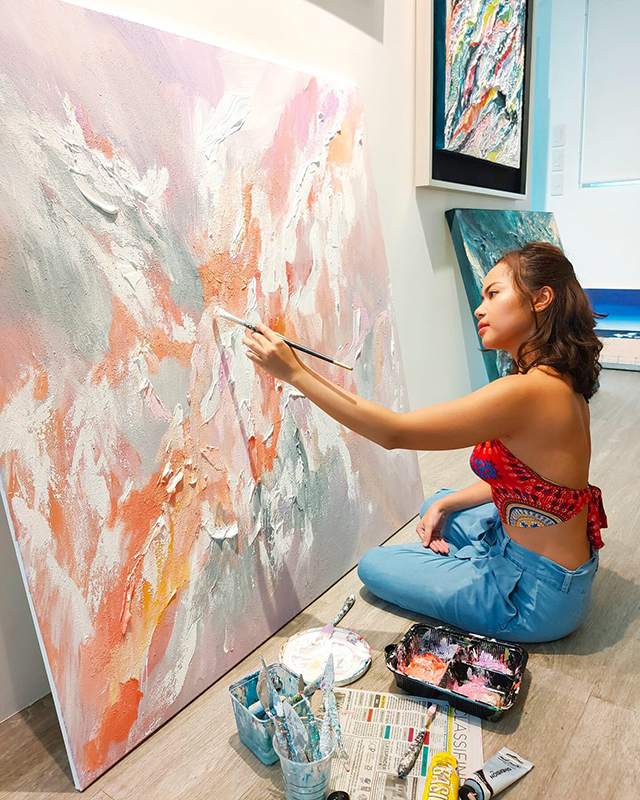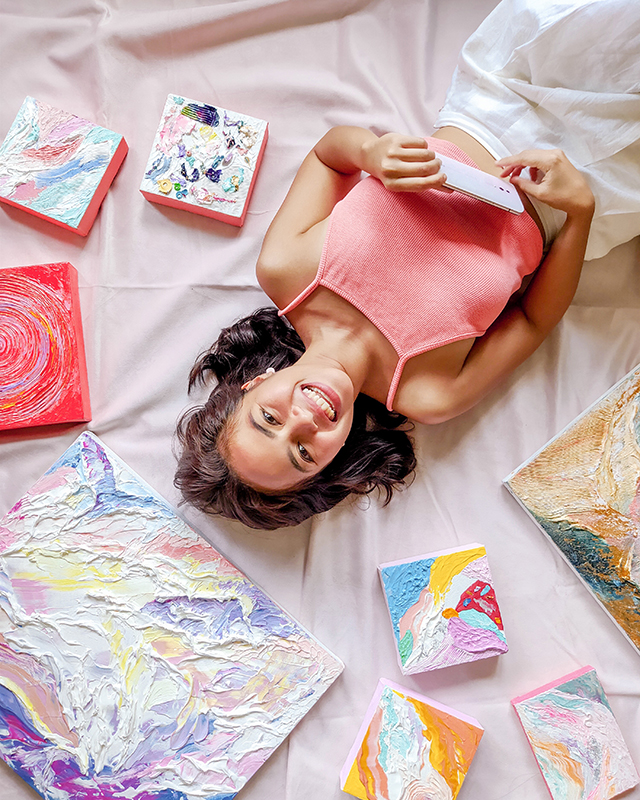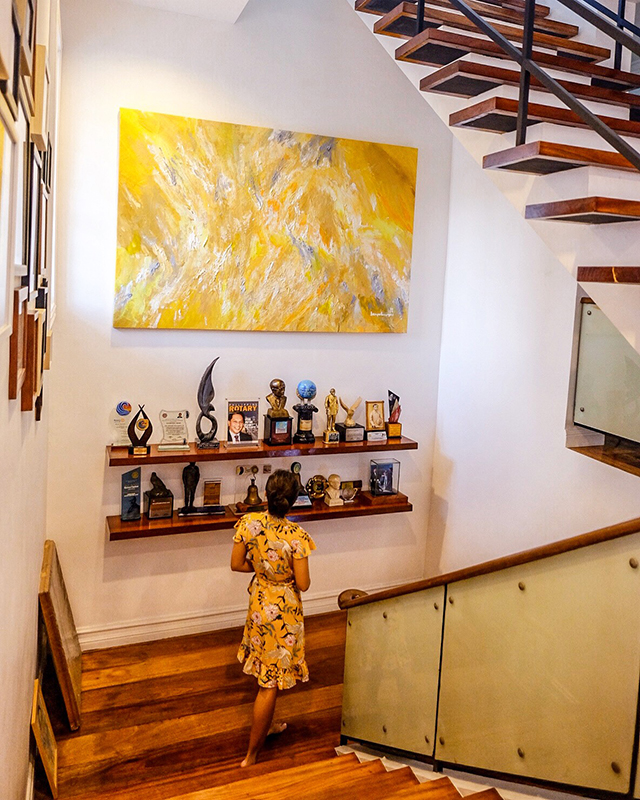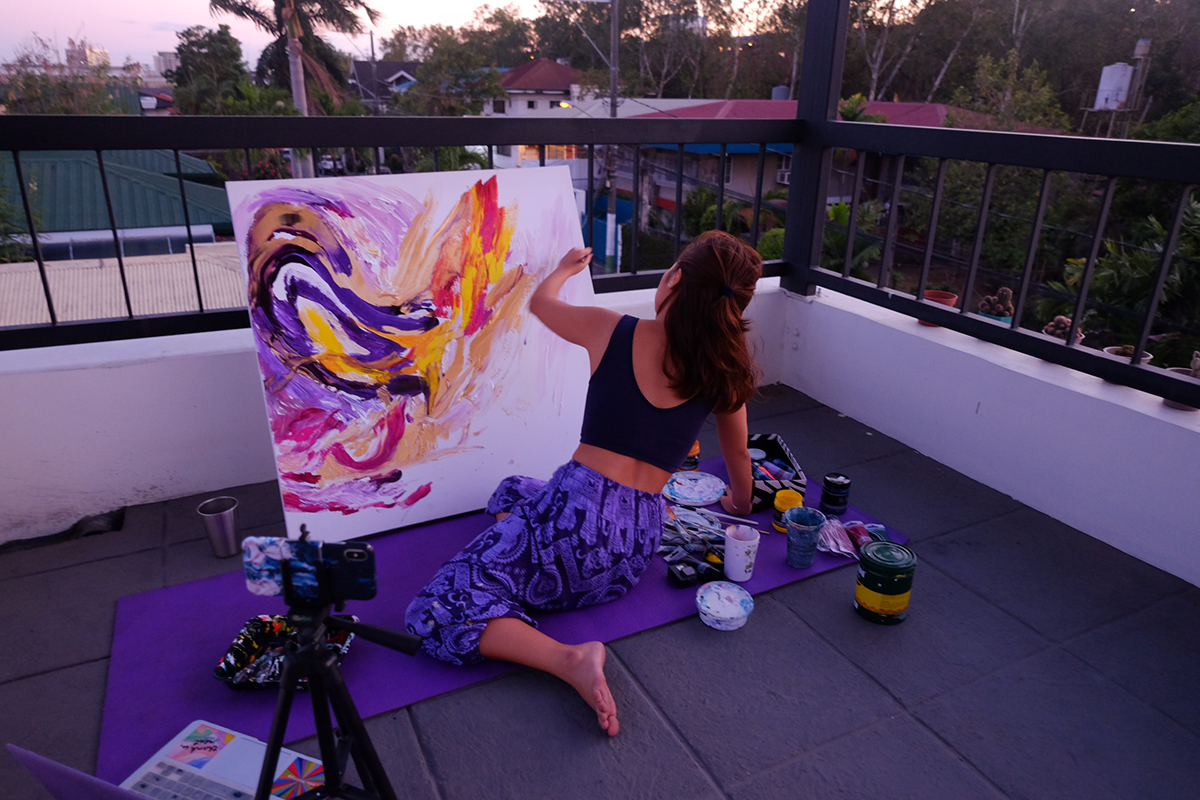Infectious is the vigor abound in Bea Policarpio’s artworks. Thick, riving textures rush over her canvases in a ripe display; through an emotion braced and channeled or an experience just weathered, she charges her impasto artworks to both pronouncement and relief. On authenticity, she believes art is always a confession. We can similarly think of it like a siphon: with one end above the surface of the reservoir, the other plunged in its bottomless pool.
What intended to be a discussion of Bea’s process bowled into daily principle, the sail toward resilience we hope, in practice and ritual, to commandeer.
Cartellino: Impasto has become something of a signature style for you. How did you arrive at this expressive form of painting?
Bea Policarpio: In 2016, I committed to a challenge trending then, which was to do something for #100days and post about the experience daily. Pushing through with my passion project #100daysofpolipaints was what got me practicing consistently. In the early days, I looked online for inspiration from artists I looked up to and quickly became fascinated by the rich textures of Justin Gaffrey’s works. I bought my first stainless steel palette knife that same week and never looked back.
Four years later, I still feel I’m best able to convey the images in my mind through impasto. The sheer volume of paint needed to achieve a thick look is what visually reminds me of the essence of abundance. When you accept the idea that creative flow comes from an infinite source, rather than from our limited selves, you take a load of pressure off yourself as an artist.
C: Your artworks are exceptionally bright and playful, often depicting movement in strong, bold strokes. Is movement a recurrent theme in your life and art?
BP: Definitely. My art is constantly changing because I am constantly changing. I would describe myself as quite an intense person, and I think those closest to me would agree (haha). I think and feel way too much, so it’s best for everyone involved that I stay connected to my painting or journaling as healthy outlets of expression.
In the past, I used to try to paint only when I am in a particularly high mood, reserving lower moods for the page rather than the canvas. Now as much as possible, I try to show up every day regardless of mood and see what happens. At this stage in my creative life, the challenge I face is learning how to sit through longer sessions and dive into larger pieces, exploring one theme to its fullest expression.
With that, I believe it’s impossible to hide your current state at the very moment the brush hits the canvas. Art is always a confession, and in every stroke is a record of that day’s fears and joys. I also view colors as codes, which makes sense as my different layers of color record many transitory moods.
C: You surf and swim, water figures prominently in your artworks. Can you tell us more about this connection/fascination?
BP: Water has always been my element. It’s deeply rooted in some of my earliest memories: my dad teaching me how to float, spending birthdays in a pool, and summer vacations by the sea. On a regular non-quarantine week, I do laps at the community pool for exercise, ideally twice a week. Swimming is my favorite form of cardio because, depending on your goal, it can be high intensity, low impact, yet above all, mentally clarifying. It’s a sacred time with myself because more time I spend in the water, the more fascinating I find it. In psychology, it’s supposed to symbolize the unconscious. I think that in itself makes it an inexhaustible source of inspiration.
In 2018, I began frequenting the surftown in San Juan, La Union, as a way to heal from heartbreak and escape the noise of Manila, even if only for a few days. Cliché but true! The experience of being surrounded by the ocean and swallowed up by its visual immensity is extremely therapeutic. When I’m far out in the water, I’m constantly taking mental snapshots, hoping that my subconscious can translate the feeling with paint later.
La Union means so much to me as a place because it was there that I discovered the joy of surfing! I was never an athlete growing up, so surfing is the first sport I really feel connected to. By all accounts, I’m still a beginner, and I love that. I relish being a student again and have so much respect for the local instructors and experienced surfers who glide with such grace! I’m currently at the stage where I need a little push identifying and catching the right waves, a skill you can only learn with enough time spent practicing in the ocean. Regardless of my skill level, I love the process of trying and failing until you ride that one good wave strong and steady—it’s a moment of pure magic.
C: What’s it like to write both poetry and paint? Do they often intersect in your practice?
BP: I think this is the first time anyone’s asked me this thoughtful question, so thank you! With that, you could say I never really thought about it before that I was “doing both”— as they happen cross currently, yes, they often intersect. In my craft, I realized the words always come before the images—at least they’re birthed in that order when it comes to drawing them out of my brain and into the physical realm. The words are my conscious “official” thoughts, while my paintings are where I let my subconscious, emotional brain take over. It’s hard for me to let go with the paint without first untangling what I want to say on paper. It’s my way of unblocking, of getting out of my own way so that I can be a vessel for creativity instead of a domineering captain of an artist. They say that clarity of writing is also clarity of thinking, and I agree.
Since quarantine, though, I’ve been writing more long-form letters that I send out as an email newsletter every Sunday at 9pm. I decided this year that I wanted to serve others more through my words, and this #StudioNotes passion project has really become my north star in these strange times. I love the process of taking reading & film material that I’ve found helpful and connecting it to this week’s state of the studio, my personal process, and the world at large. I always hope the outcome is a gift of time to the reader, words that will move them from dreaming to creating, from hiding to sharing. As with poetry, I’m obsessive about brevity and tend to edit my letters until the very last minute—the goal is that every sentence should carry its own weight, every word carefully chosen to add value to the whole. With writing, my guiding principle is something I once read: “It’s not the artist’s function to possess the poetic experience—that is a private affair. Her aim should be to create the poetic experience in others, for others.”
C: Amor Fati—Can you explain to us the meaning of your tattoo? Why Nietzsche?
BP: The Latin saying amor fati is a stoic philosophy made famous by Friedrich Nietzsche, which translates directly to “love of fate—that one wants nothing to be other than it is, not in the future, not in the past, not in all eternity. Not merely to endure that which happens of necessity, but to love it.”
I was introduced to this concept by Ryan Holiday of The Obstacle Is The Way—which is a gem everyone should read, by the way. At my time of reading, the concept of amor fati moved me profoundly as a brilliant ideal for living. It was something I desperately wanted to practice in my own life.
Amor fati is a way of being able to look into the existential void we all must face and choose to create some light during this brief stint on earth, anyway. Look, we can hardly control what happens to us, but we can always choose what to create out of it. What we make of that often becomes our art. Having it inked on my skin reminds me not merely to endure this maddening human condition, but to rise to the occasion of living through action, while I’m still able to.
C: You speak a lot into art practice to the people who follow you. It seems like for you, in the general run, the trick is to be courageous with art and see where it goes from there. Was there a time when you were paralyzed by a fear of art? How did you overcome it?
BP: Oh everyday, everyday. I’m not gonna lie to you, the terror of facing a blank canvas does not get any easier, no matter how often you do it. I hope that changes for me along the way, but I’m learning to be okay with it in case it doesn’t, because that’s where practicing courage comes in.
Tabula rasa, the state of purity, of complete blankness, is in a very real way like facing the existential void itself. The only cure for the tyranny of tabula rasa is to begin. There’s no way around it, unfortunately. To get anywhere, you must begin. The good and bad news of it is, starting is often the most difficult part. One trick that usually works for me, though, is fooling yourself into productivity with good music. I like to lie to myself and say I’ll only work on the task at hand for the length of Ariana Grande’s thank u, next album (which is exactly 41 minutes). Then, especially with painting, once I get the ball rolling, it’s hard to stop. A satisfying paint session for me lasts the length of the whole Hamilton Original Broadway soundtrack—roughly 2.5 hours. To anyone dealing with a creative block, try bribing yourself with your favorite album. You’ll put yourself in a good mood and get good work done.
Another non-negotiable for me is keeping a journal. I write at least three Morning Pages of freehand, stream-of-consciousness to exorcise my ego on the daily. I learned of this practice from the phenomenal Julia Cameron, who wrote The Artist’s Way—an invaluable manual for anyone looking to live a braver life. I use journaling as designated time and space to purge the mental noise for me to tune into the music of the infinite. For some reason, I find tabula rasa as a blank page easier for me to overcome than it is as a blank canvas. But maybe that statement is also just another way I avoid feeling the uncertainty of playing with colors and not knowing exactly where I’ll end up.
Jackson Pollock has said that “Each painting has a life of its own. I try to let it come through,” and that kinda scares me when I know it should liberate instead. Because the art itself, isn’t—or at least, shouldn’t be—about me. I’m just the messenger. This is also the same reason why I appreciate doing commissioned work for private clients and brands because, for once, it’s not all up to me. It’s a happy challenge in collaboration. I have to immerse myself in their vision, their moods, hold it up against my own, and see what the painting itself wants to be. Though I’m the one doing the painting, the act of painting is always a chance to step outside myself, if that makes any sense.
C: Another thing that comes up often is your expression for child-like wonder. With everything going on and us getting older, how do you sustain that precious quality?
BP: Humor and gratitude. No matter how much you laugh and say “thank you” on the daily already, you’ve got to let yourself do it more often. Laugh at yourself, at your mistakes, at your seriousness. Like I said, I’m actually a really intense person once you get to know me. On top of the anxiety of this global pandemic, I struggle against heavy thoughts and emotions on the regular. I try my best not to judge any passing mood and believe every negative thought. As with everything, it is a “work-in-progress” because I equally know that I have so much to be grateful for. Grounding myself in gratitude always puts me in a balanced perspective: I’m alive and well, and so is mostly everyone I care about. Being able to do creative work is its own reward, and that should be more than enough. I have no real right to complain about anything ever.
And though it’s nothing at all compared to tragedies that others have been through, I’ve weathered my fair share of storms and dark nights of the soul. With that, I fully believe there are events that halve our lives into “before” and “after”—this pandemic clearly being one of them. Applying amor fati to the equation, gratitude in spades is the only appropriate response for having survived this far. I think maybe the secret to unlocking wonder is this deep and incontrovertible appreciation for life. The days may feel mundane, but nothing about this existence is actually merely ordinary—did you know the odds of being born a human being is 400 trillion to 1? Let that sink in and every day after will begin to feel like a miracle.
On a practical level, I try to dance, sing, write, paint, and share as much as I can because expression is survival. I try to laugh a lot, mostly at myself. I love being goofy in the hopes of cracking a smile in someone else. My love language is sending and receiving memes. My latest hobby is messing around on Tiktok; it teaches us all how to have fun again. Many adults don’t get the point, but I think it’s pretty neat. We greatly underestimate the power of humor as a coping mechanism to alleviate tension and make sense of life.
Ultimately though, I can understand why we collectively struggle in the pursuit of happiness. It’s because feeling joy as an emotion feels incredibly vulnerable. We’d rather not lean into joy because we instinctively know it won’t last. And it’s true, no feeling is final—but isn’t that exactly what makes each emotion so beautifully human?
C: Just to cover all our bases, it seems like failure, ego, attaining mastery over them, and the joy that comes with that feature quite prominently for you. Like a metanarrative, so to speak. Artists dedicate their lifetimes to articulating a single, pressing idea. Would you say the same for yourself with the themes mentioned?
BP: To be quite honest, the themes mentioned accurately describe where I’m at in my personal journey and in my writing. But it didn’t occur to me that these overarching themes were also apparent in my art, at least to the viewer. Quite frankly the paintings that emerge from my studio are mysteries unto themselves—even to me. While I may assign titles and backstories to describe what mood gripped me during a painting’s creation, ultimately each person sees something different and assigns her own meaning upon encountering the piece. Having themes explicitly articulated to me by an observer is fascinating precisely for this reason.
Given all that I’ve described about my process, it only makes sense to conclude that my art is inextricably autobiographical, at least to a certain degree. But I am equally hesitant to neatly assign a single, pressing narrative to what I make. It is simply the wordlessness of art that obsesses me. I am infinitely more interested in what the painting said to you. What secrets did it reveal? What human pleasure or pain did it trigger in you? Where did it take your mind? Maybe we can compare notes and see where we land in the wild field of meaning. I am certain though, that in our search for each other through the layers of paint and color, we will hit upon that gold they call “connection.”
Postscript
BP: Getting involved with creative fundraisers for COVID-19 relief has given me a greater sense of purpose and community during this pandemic. If the spirit moves you, you can check out https://www.artsforph.com/bea-policarpio/ to purchase some affirmation art to be sent as emotional support for COVID-19 patients and frontliners alike. All proceeds will be donated to a cause of your choosing. You may also check out https://artdrop.shop/collections/bea-policarpio to support #ArtForTheFrontline. We are selling limited edition canvas art prints for the benefit of #FaceShieldDrivePlus, an initiative to supply our frontliners with PPE’s. All profits will be donated. Thank you!
Bea‘s“Sirena,” “Playground,” and select artworks from of her Tic Tac Toe and Junk of Heart series are available at the Cartellino shop.
All images courtesy the artist. Follow Bea (@polipaints) in Instagram.
Anchor photo:“Crosscurrents.” Acrylic on canvas. 24 x 48 inches. 2018.

-800-1200.jpg)

